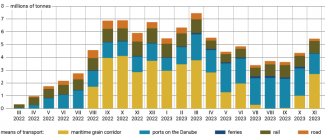Ukraine: the new Black Sea corridor is a success
On 19 December Oleksandr Kubrakov, deputy prime minister for the reconstruction of Ukraine and minister for infrastructure, announced that during the four months of operation of the Ukrainian Black Sea Corridor it had managed to export 10 million tonnes of goods, of which nearly 5 million tonnes were agricultural products. During this period the ports of Odesa, Chernomorsk and Pivdenne received 337 vessels, with a further 79 to be handled in the near future. On 11 January Turkey, Bulgaria and Romania plan to sign an agreement on demining the western Black Sea basin. Kyiv will also receive two minehunters from the UK.
Commentary
- After Russia withdrew from the Black Sea Grain Initiative on 17 July (see ‘Russia's game with the West: Moscow withdraws from the grain deal’), in August Ukraine proposed a new route running along its territorial waters towards Romania. In the first few weeks, five ships which had been trapped since the beginning of the war used the route; as of 16 September, new vessels started arriving at the ports, and their number increased steadily: there were 31 in the first 30 days, and as many as 170 over the next month and a half.
- The launch of the new corridor has had a positive impact on Ukrainian agricultural exports, which reached their highest level in six months in November (see graph). In addition, unlike the previous grain corridor, the use of the new route is not limited to food exports alone, but it is also used for foreign sales of other commodities, primarily iron ore and metallurgical products. This will potentially allow Ukraine to increase its industrial production in these sectors; before the war they had mainly been export-oriented, and were dependent on the sea route.
- The most serious challenges associated with the new route relate to security. Russia is continuing its attacks on Ukrainian port infrastructure, and in November a Liberian-flagged ship was hit by a rocket as it entered one of the ports. Despite casualties, however, the incident did not paralyse traffic on the new route. In addition to direct attacks, floating mines are a problem; this is why the trilateral mine clearance initiative in the western Black Sea is important to enhance the safety of shipping.
- The Russian Black Sea Fleet (BSF)’s capabilities to paralyse the ship traffic along the stretch of Ukrainian territorial waters (from near Odesa to the Danube delta) of nearly 200 km are very limited. In the face of Ukrainian missile strikes on Crimean ports and naval drone attacks during 2023, the invaders have concentrated the bulk of their warships in Novorossiysk, almost 600 km from Odesa as the crow flies. This distance means that the primary means of destruction normally used against merchant ships cannot be employed, with the exception of expensive and scarce Oniks and Kalibr cruise missiles. In turn, fearing Ukrainian anti-ship missiles and anti-aircraft defences, the Russians are avoiding operating at sea or in the airspace west of Sevastopol. This means that direct strikes by BSF warships and fighter planes against ships sailing along the new corridor have become much riskier. However, the ships may be threatened by naval drones, the introduction of which has recently been announced by Russia.
Chart. Monthly exports of Ukrainian agricultural production since the outbreak of war by mode of transport

Sources: Ministry of Agricultural Policy and Food of Ukraine, Humanitarian Data Exchange, Spike Brokers.





